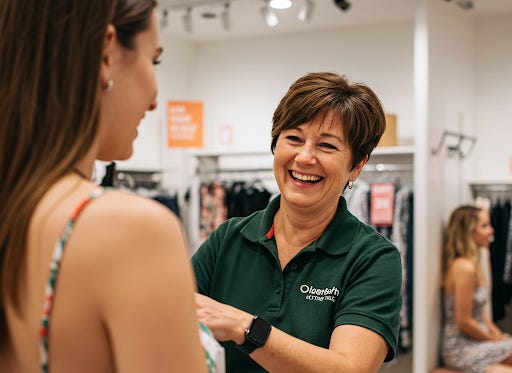When you last went into a shop, how did the experience feel? I’d like to think that you had a nice chat, got some great recommendations on products and left feeling fulfilled and keen to return. Too often, however, the experience is a great deal less than that - with colleagues in store over-worked, under-houred, under-trained and so beaten down by retail theft and customer rudeness that the last thing they want to do is chat.
In this digital age, where algorithms predict our desires before we do, the humble brick-and-mortar store is fighting for its life. That’s been the focus of this Thrive in 25 series and this week we add to our recent posts about Experiences and Personalisation with physical retail’s most potent weapon: genuine human connection.
This is obviously an expansion of the ‘Experience’ topic. In that post, I listed as one of the possible experiences you could create in store as “frankly, just a nice chat about the weather and how awful the parking is”. It is that, rather than the more involved experiences that I’ve been thinking about since and which this post addresses.
The last time I wandered down Oxford Street provided a great illustration of the good and the bad kind of retail interaction. Wandering into a cool(ish), new(ish) retail brand aimed squarely at teens and young adults, I found a store team who were obviously tired, bored and didn’t want to be there. The experience they inadvertently created was the exact opposite of the one that would encourage their target market to part with cash and there was precisely zero customer interaction going on. Wander a bit further up to Lush, on the other hand, and an engaged, interactive, cheerful set of colleagues was talking to customers constantly and showcasing exactly how it should be done.
For another example, I was struck by a visit to Lakeland in Cambridge a few months ago by the warm positive energy the team in store were generating and their ability to have, in just a short interaction, a nice chat with anyone wandering in who wanted one. That, and an informative exchange about silicon pastry cutters, marked the whole experience as much richer than their own website, let alone their pureplay competitors.
If we aren’t careful, we are in danger of thinking about our greatest asset - our colleagues in stores - as a cost to be engineered out rather than as what they are - our best line of defence against the internet warehouses. If our view of store teams is only as a cost line, then we end up over-focussing on speed and efficiency, at the expense of everything else.
But here’s the truth: people crave experiences, not just products. And a positive, human experience is the ultimate differentiator.
And it’s not just about immediate sales. A positive in-store experience fosters loyalty. It cultivates brand advocates. People remember how you made them feel. And in a world where everyone is shouting about discounts and deals, a genuine smile can be a powerful, resonant message.
Viewed through this lens, then, it is clear that regarding the money you invest in your colleagues in store as a cost to be ‘optimised’ (the cost of moving product from stock room to shelf and of managing the tills) is, for many retail businesses, completely the wrong lens to use.
Better, then, to consider your colleagues as ‘ambassadors for your brand’, there to interact with customers, explain things to them and generally make the store experience a more real and enjoyable one than clicking on a website can ever be.
Of course, this requires a change in approach. It means investing in training, not just in product knowledge, but in interpersonal skills. It means empowering colleagues to be authentic, to bring their personalities to the shop floor. And yes, it means hiring people who genuinely enjoy interacting with others.
Some retailers are already nailing it. Think of the charming independent bookstore where the staff are always ready with a personalized recommendation. Or the bustling local market where the vendors remember your name and your favourite produce. These places thrive because they understand the magic of human connection.
But too many retailers are still stuck in a robotic rut, treating their colleagues like automatons and their customers like numbers. They’re missing a golden opportunity to create a unique and memorable shopping experience.
Now all of this might sound a bit new-age and hippy, and of course it isn’t a mandate to stop thinking about the cost of operating stores at all. There will still be a ‘right’ number of hours for you to deploy in any given store in any given week. It’s just that the way you calculate that ‘right’ number is different if you are solving for ‘maximum impact on customers per hour deployed’ rather than just ‘what’s the smallest number of hours we can deploy without the store burning down’.
Solving this different equation is a difficult challenge for big retailers deploying thousands of colleagues in hundreds of stores. As business leaders, it challenges our norms in HR, Central Operations, Regional Management and Store Operations. All of these functions need to think differently if you are to put the value of customer interaction at the heart of your business. The questions they need to answer are more subtle and more difficult in that new paradigm.
That is a challenge worth rising to, however. For any retailer, whether a small indie with 2 or 3 long-serving colleagues or a massive chain with complex cost-management models, if you can unlock the power of your ambassadors you can lift your interactions with customers above the purely cost-based.
And that is a prize with real value.





That Oxford St store was presumably cool(ish) and new(ish), and flagship(ish) too. But brands still too often take the West End crowds (?) for granted.